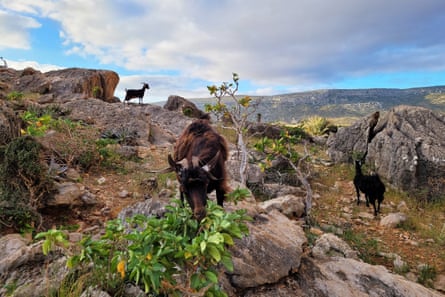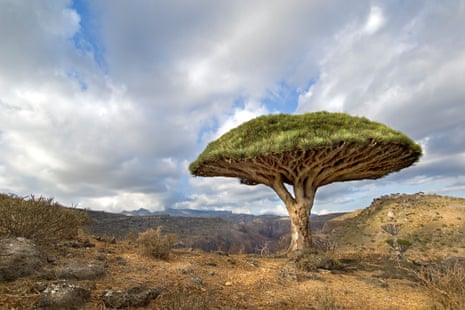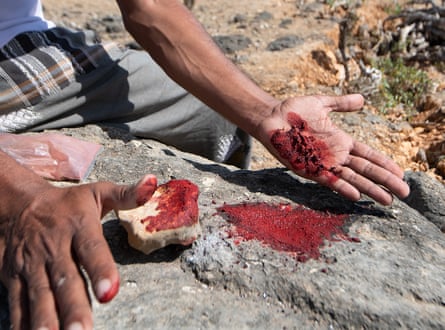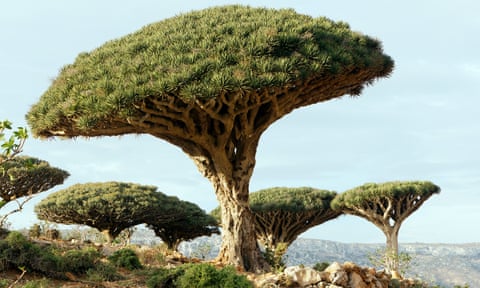Just after 4am on the Diksam plateau, near the centre of Yemen’s Socotra Island, a loudspeaker stirs local people from their sleep with the day’s first call to prayer. A heavy fog drifts over the plateau and a breeze ruffles a half-dozen green and blue nylon tents sheltering American and European tourists who have come to glimpse one of the island’s most iconic and otherworldly species: a strange, upside-down tree called the dragon’s blood (Dracaena cinnabari).
As the sun rises, the fog recedes, illuminating a small cluster of buildings that form the village, the campsite and, to the west, a single paved road winding its way past the jagged Hajhir mountains toward the northern coast.
By 6am the village is buzzing with activity. The campsite owner, Mohammed Salem Abdullah Masoud, known as Keabanni, sits in a clearing on a foam mattress. He is joined by his eldest son, Salem Mohammed Salem Abdullah, a tour guide and conservationist. Both wear sandals, T-shirts and traditional skirt-like attire called foutas, and sit cross-legged eating a breakfast of tea, dates and a pancake-like bread called malawah smeared with soft white cheese and honey. Keabanni, who is in his mid-50s, is talking about the remarkable dragon’s blood tree that grows on the island’s mountains and high plateaux and nowhere else on Earth. “The dragon’s blood tree is the heart of Socotra,” he tells me in the Socotri language, as Salem translates.
When Keabanni was a child, his great-grandparents told stories of vast forests of dragon’s blood trees. Across the plateau, they said, there were so many trees that you could walk from the shade of one to the shade of another without the sun ever touching you. Like his parents and grandparents, they were nomadic pastoralists, moving from place to place to feed and water their cattle. “It was the Bedu lifestyle,” Keabanni says, referring to the Bedouin ethnocultural group found across the Middle East and north Africa.

The rapacious eating habits of Socotra’s goat population are thought to have contributed to the decline of the dragon’s blood tree. Photograph: Jess Craig
At night, families set up camp around the trees, and during the day, the trees’ umbrella-shaped crowns of stiff, densely packed leaves provided relief from the island’s intense midday sun. The bright red resin that seeps from the dragon’s blood trunk when it is cut was ground into a fine powder and sold to Greek, Arab and Indian merchants who transported it around the world where it was used in paint and pottery glaze, makeup and nail polish, as ointment for cuts and scrapes, or as an elixir to treat anything from diarrhoeal disease to postpartum bleeding.
In recent decades, however, the pressures of human activity and a changing climate have taken their toll. Some scientists predict that the dragon’s blood tree will experience a steep decline in the next 30 to 80 years, and may one day be gone altogether. “The long-term future of this species is not hopeful,” wrote Petr Maděra, a professor of forest botany at Mendel University in the Czech Republic, in a 2019 paper.
Keabanni, however, is not letting the trees go without a fight. For the past 20 years, his Diksam campsite has served as a sort of dragon’s blood conservation headquarters, with a nursery and informal research centre.

The dragon’s blood tree is classified as a vulnerable species on the IUCN red list. Photograph: Neil Lucas
Setting out towards Firmhin, a plateau north of Diksam where dragon’s blood trees are still abundant, the first dragon’s blood to be seen, on the outskirts of the village, is a lone tree on an expanse of barren, rocky soil a few feet off the dirt road. The tree is perhaps 15ft tall, with a thick, ash-white trunk kinked in the middle, scarred from previous resin harvesting. At the top of the trunk, thick and scaly branches terminate in a crown of long, thin leaves that resemble a well-watered bluegrass lawn.
Most trees draw water from the soil and up their roots to the leaves; dragon’s blood trees can also do the reverse, taking water from the air and passing it into the soil. Scientists suggest that the unique shape of the dragon’s blood tree is an adaptation to life in its arid environment, allowing the trees to capture moisture from the fog and clouds, a process called horizontal precipitation capture. Researchers estimate that each dragon’s blood tree can inject several times more water into the soil than the local environment captures as rainfall, providing a critical component of the island’s hydrological system.
“One dragon’s blood tree brings a huge amount of water into the system,” says Kay Van Damme, a European researcher at Ghent University in Belgium and Mendel University, who is also the chair of the UK-based volunteer group Friends of Socotra and has worked on the island since the late 1990s. “If you lose a tree, you also lose hundreds of litres of water each year that would otherwise go into the system,” he says.

Crushed resin from the dragon’s blood tree has long been used in pottery, paint and medicine. Photograph: Jess Craig
Considered an “umbrella species”, not in reference to its shape but rather to the ecological role it plays, the dragon’s blood tree helps support dozens of other plant and animal species, from geckos and snakes to flowering plants. One group of researchers studied the plants found living in the understory of a dragon’s blood tree compared to open areas and identified 92 plant species in total, 32 of which, including seven endemic species, were found to grow exclusively near dragon’s blood trees.
Driving on, the trees start to become more abundant. And then, across a deep gorge, the Firmhin plateau comes into view. Thousands of dragon’s blood trees dot the rocky terrain.
But for every dozen or so living trees, there are several downed trees nearby, white trunks cracked in the middle, the massive crown toppled, and the white, leafless branches like bones protruding from the ground.
In Arabic, the dragon’s blood tree is known as Dam al-Akhawain, or “the blood of the two brothers”. According to folklore, the first dragon’s blood tree grew in the spot where two brothers, Darsa and Samha, fought each other to the death. Another story holds that the trees sprouted from the drops of blood shed by a dragon while it fought an elephant. Today, the Firmhin plateau is part forest, part dragon’s blood graveyard.
Two major factors are driving the dragon’s blood tree to the brink, according to scientists. The climate crisis is one. Socotra’s tropical desert climate has always been extreme but in recent decades, dwindling rainy seasons have caused prolonged and severe droughts, which means less moisture in the soil, leaving saplings struggling to survive.
Extreme and unpredictable weather systems, probably fuelled by warming oceans, have brought devastating winds and flooding to Socotra in recent years. In 2015, two cyclones hit the island and in one week wiped out about 30% of Socotra’s trees.

The leafless crown of a toppled dragon’s blood tree in the Firmhin forest. Photograph: Jess Craig
Overgrazing is also a key factor in the trees’ decline. Maděra estimates that there are four goats to every human on the island, eating everything in their path, including dragon’s blood saplings.
Most of the dragon’s blood trees in the wild today are probably hundreds of years old, though their exact age is impossible to calculate, because they have no rings in their trunks. But without a younger generation to replace them, the current generation could be the last.
At 1,400 sq miles, Socotra is the largest of four islands in the Socotra archipelago, about 210 miles off the southern coast of Yemen. The archipelago is one of the most biodiverse places in the world, nicknamed the “Galápagos of the Indian Ocean”. An estimated 37% of the island’s 825 plant species, 90% of its reptiles and 95% of its land snails are endemic, meaning they are found nowhere else on Earth. In 2008, Unesco named the Socotra archipelago a natural world heritage site.
Located between the Arabian Sea and Indian Ocean, Socotra has been occupied by or played host to British, Portuguese and Russian forces, whose rusted tanks still line the island’s northern coastline. But those occupations came and went and in 1967, the same year that Keabanni was born in a mountain cave about 10 minutes from Diksam, the British relinquished colonial control of the southern half of what is now the Republic of Yemen. The new Yemeni government annexed Socotra as a protected military zone, restricting movement on and off the island and it remained nearly impossible to visit it until the late 1990s when, after the brief 1994 civil war, southern and northern Yemen reunified and formed the modern-day state.

Salem Mohammed Salem Abdullah, a tour guide and local conservationist, walks around the dragon’s blood nursery that he cares for with his father. Photograph: Jess Craig
Van Damme believes that that these restrictions – combined with Socotra’s nomadic pastoralist culture, which fosters a close connection between the people and their environment – helped keep the ecosystem largely intact. “That is why Socotra is really unique. What you see now is how many islands would have looked 300 or 400 years ago when there was still a chance to protect them,” he says.
But the island is changing. After unification, the Yemeni government, with assistance from international aid groups and foreign governments, began upgrading the island’s infrastructure. The opening of the island to outsiders ushered in a wave of scientific research and conservation, but also modernisation and urbanisation.
The continued development and influx of foreign money mean that today no part of the island’s capital is untouched by construction. Nor has the development spared Diksam or the Firmhin plateau.
Today, the UN Environment World Conservation Monitoring Centre and the International Union for Conservation of Nature (IUCN) classify 157 plant species on Socotra as vulnerable, endangered, or critically endangered. This includes the dragon’s blood tree, which the IUCN classifies as a vulnerable species.

Salem rests his hand on the scarred trunk of a dragon’s blood tree. Photograph: Jess Craig
Salem is working with the Mendel University research team on a species monitoring project to locate and measure individual dragon’s blood trees on the island. When he comes across one, he opens a phone app and looks to see if the tree has been recorded. If it hasn’t, he collects the tree’s GPS coordinates, measures the trunk’s circumference, approximates the tree’s height, and records relevant data such as the presence of pests or evidence of branch cutting or resin harvesting. When the survey is complete in the next few years, researchers should have a comprehensive baseline for every dragon’s blood tree across the island.
A few steps from the Diksam campsite sits the nursery where, for the past 20 years, Keabanni and Salem have been raising dragon’s blood saplings. Behind a 6ft stone wall, the saplings stand knee-high in rows spaced a couple of feet apart. Nearly 20 years old now, they look more like spiky bushes than trees, big enough to capture horizontal precipitation but still too small to avoid falling victim to goats. Every few days, Keabanni checks for goat incursions.
When Maděra and Van Damme first met Keabanni in the early 2000s, they recognised that “he was a man who [knew] every tree on the island, every species”, Maděra recalls. The scientists wanted to engage local people in the conservation efforts from the beginning. “The only way conservation can work is if it is owned by local people,” says Van Damme. “They are the experts in knowing how to take care of their land, their animals, their plants, because they are living there.”




Clockwise from top left: The distinctive crown of a dragon’s blood tree; the damage done to a young tree by goats; removing a snail; and a full-grown dragon’s blood tree. Photographs: Jess Craig
In all, Van Damme, Maděra, and Keabanni planted about 800 saplings. The Mendel team provided the initial scientific expertise, technical assistance, tools and funding, while Keabanni looked after the saplings.
Today, the saplings no longer require regular watering, but Keabanni still visits every few days to guard against the persistent threat of goats. He estimates that the animals have eaten about 200 saplings over the years, and almost all the 600 surviving plants have been gnawed at the ends.
Once the saplings have grown tall enough, the dragon’s blood trees will be moved to the wild. But dragon’s blood trees are exceptionally slow growing, only 2.65cm over a five-year period.
Keabanni knows he will probably never see the fruits of his labour. But perhaps his grandchildren will see a dragon’s blood forest once again in Diksam.

The trees still thrive in some places on Socotra, but for how much longer remains to be seen. Photograph: Sylvain Cordier
A longer version of this story was originally published in bioGraphic, an independent magazine about nature and regeneration powered by the California Academy of Sciences
